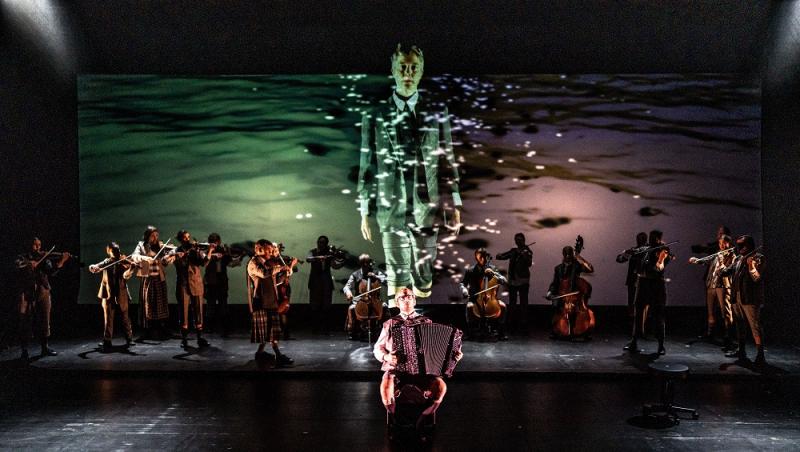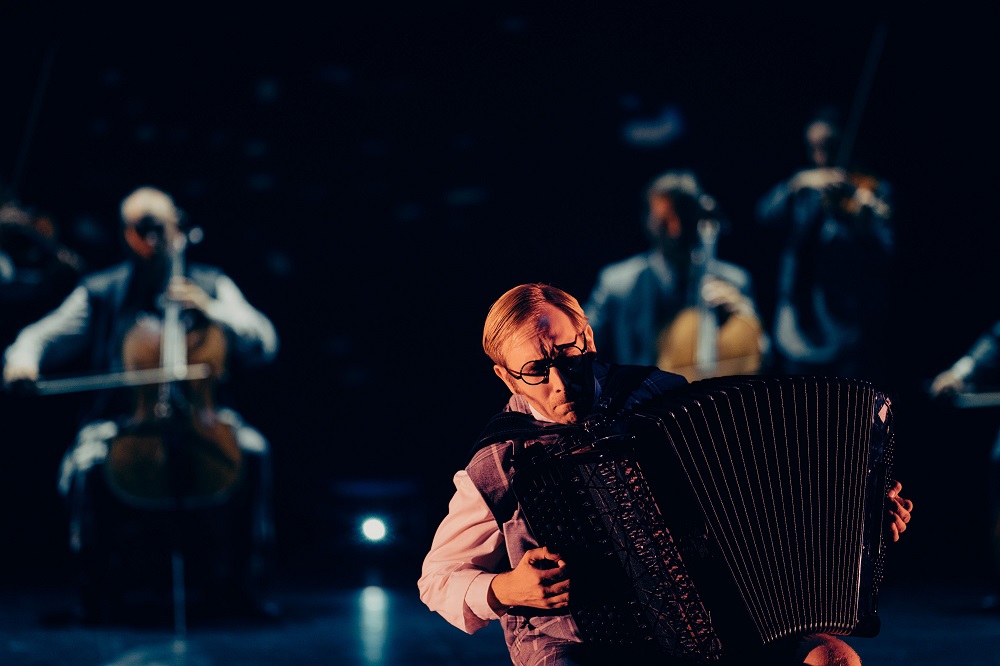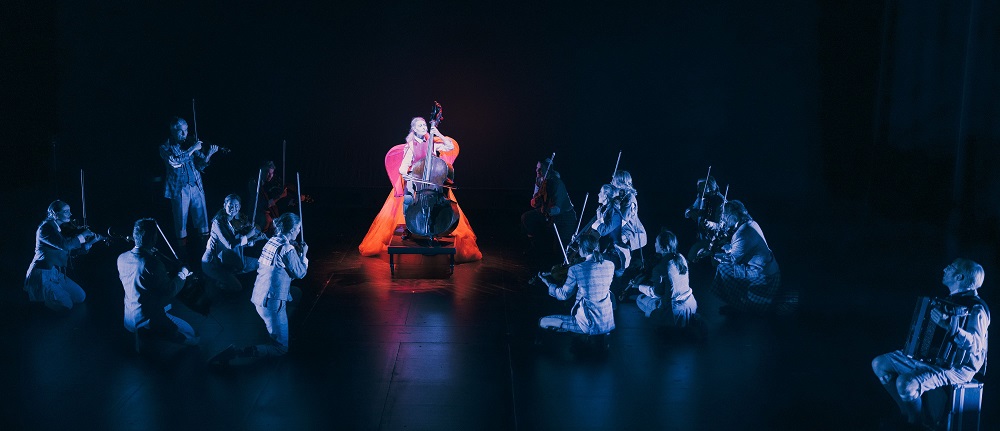Concert Theatre DSCH, Norwegian CO, Oslo Opera House Scene 2 review - Shostakovich choreographed for strings and accordion | reviews, news & interviews
Concert Theatre DSCH, Norwegian CO, Oslo Opera House Scene 2 review - Shostakovich choreographed for strings and accordion
Concert Theatre DSCH, Norwegian CO, Oslo Opera House Scene 2 review - Shostakovich choreographed for strings and accordion
90 minutes of by-heart playing with movement from some of the world's best players

Do we really need instrumental Shostakovich with lighting, movement, costumes and video projection? I might have said no before having seen what the Norwegian Chamber Orchestra could do with former leader Terje Tønnesen, performing the Chamber Symphony by heart in dramatic style. It seemed likely that memorizing even more music under new Artistic Director Pekka Kuusisto, and performing it in an insanely demanding dramatic framework, with no word spoken, could work.
It does, beyond anyone's wildest imaginings. This collaboration is with a visionary Danish team: director Mikkel Harder Munck-Hansen, who chose most of the music from an encyclopedic knowledge of Shostakovich and knows how to alternate light, light-serious and profound; lighting, scenography and video design by Lars Egegaard Sørensen rising from near-darkness; and beautifully tailored, androgynous costuming by Maja Ravn, which shouldn't work but does. Within this the music-making, whatever the players are asked to do, remains paramount. We start with an eerily rotating moon, the desolation of the composer's swansong Viola Sonata played by Ida Klokk-Bryhn, who's soon joined by eerie accordion sounds from Bjarke Mogensen (another Dane, and one of the world's great players – pictured above – whom I first heard him in a stunning transcription of Stravinsky's complete Petrushka with fellow-accordionist Rasmus Schjærff Kjøller).
Within this the music-making, whatever the players are asked to do, remains paramount. We start with an eerily rotating moon, the desolation of the composer's swansong Viola Sonata played by Ida Klokk-Bryhn, who's soon joined by eerie accordion sounds from Bjarke Mogensen (another Dane, and one of the world's great players – pictured above – whom I first heard him in a stunning transcription of Stravinsky's complete Petrushka with fellow-accordionist Rasmus Schjærff Kjøller).
If there is any biographical hint in the evening, it's in the round glasses which suggest Mogensen as the often lonely composer. But thankfully nothing is tied down to the anecdotal, and there's not an image of Stalin or even of Soviet Russia to be found. Contrast is of the essence. Two violinists back to back suggest eccentric revue; double-bass player Katrine Sonstad as a red-clad angel dominates the ensemble as she takes the cello's part (pictured below), while cellist Øystein Sonstad takes centre stage in the most flamboyant tour de force of the evening, the other players stamping and instrumentally shouting around him in the opening movement of the First Cello Concerto. Kuusisto's preliminary burlesque as a grotesque wielding a bass drum plays off with his well-timed strokes during the movement; otherwise, at least until the Chamber Symphony, he's totally part of the team.  Sonstad is also an arranger of genius; only the lower string soloists are allowed to play the familiar tune of the Waltz from the Second Jazz Suite against a lyrical natural background. The decision to take the limpid neoromantic Andante of the Second Piano Concerto and entrust it to Mogensen's extreme sensitivity is one of many moving surprises.
Sonstad is also an arranger of genius; only the lower string soloists are allowed to play the familiar tune of the Waltz from the Second Jazz Suite against a lyrical natural background. The decision to take the limpid neoromantic Andante of the Second Piano Concerto and entrust it to Mogensen's extreme sensitivity is one of many moving surprises.
The co-ordination required between playing and precise music-theatre defies belief. The nervy opening movement of the Seventh String Quartet is not only shared between two groups, sometimes joining, but in Munck-Hansen's imaginative choreography against a forest viewed through train windows requires the players to change their seats on suitcases with eye-popping regularity (pictured below).  The players are occasionally required to observe a stony impassiveness against the grain of the emotional music they're playing, as in the opening of the Eighth Symphony, but this too works, especially when Grønsdal evokes a narrative of figures emerging to reach giant form before vanishing or collapsing. Sometimes the musical demands are so great that a freer wildness is allowed, as in a stupendous inferno of a second movement from the Two Pieces for String Octet. Sure-footed contrast allows Mogensen to follow this with a necessary sweet resting place in the Romance from the Dances of the Dolls, the one piece I didn't recognise; it sounded like a perfect, briefly Bachian preludes.
The players are occasionally required to observe a stony impassiveness against the grain of the emotional music they're playing, as in the opening of the Eighth Symphony, but this too works, especially when Grønsdal evokes a narrative of figures emerging to reach giant form before vanishing or collapsing. Sometimes the musical demands are so great that a freer wildness is allowed, as in a stupendous inferno of a second movement from the Two Pieces for String Octet. Sure-footed contrast allows Mogensen to follow this with a necessary sweet resting place in the Romance from the Dances of the Dolls, the one piece I didn't recognise; it sounded like a perfect, briefly Bachian preludes.
While this is being played, the other participants move onstage and discreetly tune up – it's also part of the action – for a complete performance of the Chamber Symphony (Rudolf Barshai's arrangement of the Eighth String Quartet; pictured below). Kuusisto is very much the leader here, as was Tønnesen, but the dynamic is quite different, less a drama of the individual persecuted by the masses, more a stonier start which makes the following movements all the more striking in their dramatically expressed ferocity. Sonstad manages the poignant reminiscence from Lady Macbeth of Mtsensk, the only ray of tentative light in the entire work, more ethereally than I've heard it even from a string-quartet cellist (he is a member, incidentally, of the Oslo Quartet).  Then Kuusisto goes eerily off-string to signal the final ritual. It's all ineffably well paced, logical, inevitable, and it unfolds against perfect skyscapes: black clouds rushing forward, going in to sulphurous retreat, flaming red, settling to sunset and then a couple of stars in the darkening sky. The moon and the viola return for an equally perfect epilogue. The sound, incidentally, involves mikes on each of the players, but not for amplification, just to catch them when they move. I wouldn't have known, so homogenous is the tone in ensembles, so naturally beautiful. I've never experienced anything quite like this; it has to come to London.
Then Kuusisto goes eerily off-string to signal the final ritual. It's all ineffably well paced, logical, inevitable, and it unfolds against perfect skyscapes: black clouds rushing forward, going in to sulphurous retreat, flaming red, settling to sunset and then a couple of stars in the darkening sky. The moon and the viola return for an equally perfect epilogue. The sound, incidentally, involves mikes on each of the players, but not for amplification, just to catch them when they move. I wouldn't have known, so homogenous is the tone in ensembles, so naturally beautiful. I've never experienced anything quite like this; it has to come to London.
- Concert Theatre DSCH runs until 8 June at Scene 2 of Oslo Opera House
- There will be a Q&A on theartsdesk with Pekka Kuusisto shortly before his Prom with the Deutsche Kammerphilhamonie on 16 July
- More classical reviews on theartsdesk
rating
Explore topics
Share this article
The future of Arts Journalism
You can stop theartsdesk.com closing!
We urgently need financing to survive. Our fundraising drive has thus far raised £49,000 but we need to reach £100,000 or we will be forced to close. Please contribute here: https://gofund.me/c3f6033d
And if you can forward this information to anyone who might assist, we’d be grateful.

Subscribe to theartsdesk.com
Thank you for continuing to read our work on theartsdesk.com. For unlimited access to every article in its entirety, including our archive of more than 15,000 pieces, we're asking for £5 per month or £40 per year. We feel it's a very good deal, and hope you do too.
To take a subscription now simply click here.
And if you're looking for that extra gift for a friend or family member, why not treat them to a theartsdesk.com gift subscription?
more Classical music
 Kempf, Brno Philharmonic, Davies, Bridgewater Hall, Manchester review - European tradition meets American jazz
Bouncing Czechs enjoy their Gershwin and Brubeck alongside Janáček and Dvořák
Kempf, Brno Philharmonic, Davies, Bridgewater Hall, Manchester review - European tradition meets American jazz
Bouncing Czechs enjoy their Gershwin and Brubeck alongside Janáček and Dvořák
 Solomon, OAE, Butt, QEH review - daft Biblical whitewashing with great choruses
Even a top soprano and mezzo can’t make this Handel paean wholly convincing
Solomon, OAE, Butt, QEH review - daft Biblical whitewashing with great choruses
Even a top soprano and mezzo can’t make this Handel paean wholly convincing
 Two-Piano Gala, Kings Place review - shining constellations
London Piano Festival curators and illustrious friends entertain and enlighten
Two-Piano Gala, Kings Place review - shining constellations
London Piano Festival curators and illustrious friends entertain and enlighten
 Echo Vocal Ensemble, Latto, Union Chapel review - eclectic choral programme garlanded with dance
Beautiful singing at the heart of an imaginative and stylistically varied concert
Echo Vocal Ensemble, Latto, Union Chapel review - eclectic choral programme garlanded with dance
Beautiful singing at the heart of an imaginative and stylistically varied concert
 Scott, Irish Baroque Orchestra, Whelan, RIAM, Dublin review - towards a Mozart masterpiece
Characteristic joy and enlightenment from this team, but a valveless horn brings problems
Scott, Irish Baroque Orchestra, Whelan, RIAM, Dublin review - towards a Mozart masterpiece
Characteristic joy and enlightenment from this team, but a valveless horn brings problems
 Classical CDs: Voice flutes, flugelhorns and froth
Baroque sonatas, English orchestral music and an emotionally-charged vocal recital
Classical CDs: Voice flutes, flugelhorns and froth
Baroque sonatas, English orchestral music and an emotionally-charged vocal recital
 Kanneh-Mason, Britten Sinfonia, Shave, Milton Court - a grin and a big beaming smile
A pair of striking contemporary pieces alongside two old favourites
Kanneh-Mason, Britten Sinfonia, Shave, Milton Court - a grin and a big beaming smile
A pair of striking contemporary pieces alongside two old favourites
 theartsdesk at the New Ross Piano Festival - Finghin Collins’ musical rainbow
From revelatory Bach played with astounding maturity by a 22 year old to four-hand jazz
theartsdesk at the New Ross Piano Festival - Finghin Collins’ musical rainbow
From revelatory Bach played with astounding maturity by a 22 year old to four-hand jazz
 First Person: Manchester Camerata's Head of Artistic Planning Clara Marshall Cawley on questioning the status quo
Five days of free events with all sorts of audiences around Manchester starts tomorrow
First Person: Manchester Camerata's Head of Artistic Planning Clara Marshall Cawley on questioning the status quo
Five days of free events with all sorts of audiences around Manchester starts tomorrow
 Goldscheider, Brother Tree Sound, Kings Place review - music of hope from a young composer
Unusual combination of horn, strings and electronics makes for some intriguing listening
Goldscheider, Brother Tree Sound, Kings Place review - music of hope from a young composer
Unusual combination of horn, strings and electronics makes for some intriguing listening

Add comment